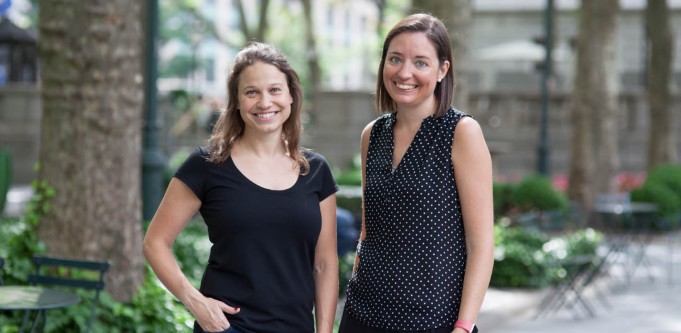
MealPal co-founders Katie Ghelli and Mary Biggins. Source: Supplied.
US startup MealPal has scrapped its subscription service model in Australia, switching instead to a membership marketplace model, which it says will offer consumers more choice of dining options, while opening up the platform to higher-end eateries.
Founded in 2016 by Mary Biggins and Katie Ghelli, and headquartered in New York, MealPal allows consumers to pre-order meals at participating restaurants, offering discounts of up to 50%.
Since launching in the US, it has expanded to Canada, the UK, Singapore, France and New Zealand. It launched in Sydney and Melbourne in 2017.
Previously, the startup has offered a 12-meal lunch plan for $7.99 per meal. However, speaking to StartupSmart, Biggins says the new model will allow for varying prices, with some meals available for $6.99 and others going for higher price points of up to $10.99.
There will still be a ‘membership’ aspect to the model, however, with consumers paying a monthly fee to access the platform, something Biggins likens to an Amazon Prime or Costco membership.
“We learnt a lot in the past two years and facilitated a ton of reservations,” Biggins says.
“But, we realised the subscription model made it very difficult for us to bring on some of the higher-end restaurants, and some higher-priced meals.”
The change has meant MealPlan has been able to onboard more than 100 new restaurants, the founder says.
“It really gives a lot more flexibility to consumers.”
A growing and profitable business
Australia is the first market in which MealPal is moving away from the subscription model. However, Biggins stresses that it’s not because it wasn’t working here.
In fact, “Australia has been one of our fastest-growing markets”, she says.
The startup first ran a test for a marketplace-only service in London, another strong market for MealPal. But it was a stealth test kept “behind the curtain for most users”.
However, through that test Biggins and the team were able to learn enough to go ahead with the change in Australia.
“Because it’s been a good market for MealPal and we have a big user-base there, and because it’s somewhat isolated from all of our other markets, it makes it a good market to really roll out the product in,” she explains.
However, messing with a model that was working was “one of the hardest things about making this change”, she admits.
“We have a good and growing and profitable business in Australia, but we believe that this is going to be bigger and better for both consumers and restaurants in the long run.”
Subscriptions aren’t going anywhere
In many ways, as subscription models become a more and more popular way of doing business, MealPal’s move feels a tad against the grain.
But Biggins believes it depends on the consumer.
“There are certainly consumers who like making that commitment and they really like having that budgeted amount for their lunch,” she explains.
“But for people who have meetings during their lunch, or lunches out of the office, or they travel sometimes, the product really wasn’t accessible.”
The new product is designed to cater to a wider-reaching group of people, creating “a better overall experience for a larger market”.
And Biggins doesn’t believe subscriptions models are on the out entirely.
“I don’t think they’re going away, but I do think consumers want more flexibility,” she says.
“To build an enduring consumer product you have to do two things really well. You have to save consumers money and you have to make the experience better,” she explains.
“I think subscriptions are one avenue whereby you can save consumers money, but there are other approaches to that as well.”


COMMENTS
SmartCompany is committed to hosting lively discussions. Help us keep the conversation useful, interesting and welcoming. We aim to publish comments quickly in the interest of promoting robust conversation, but we’re a small team and we deploy filters to protect against legal risk. Occasionally your comment may be held up while it is being reviewed, but we’re working as fast as we can to keep the conversation rolling.
The SmartCompany comment section is members-only content. Please subscribe to leave a comment.
The SmartCompany comment section is members-only content. Please login to leave a comment.